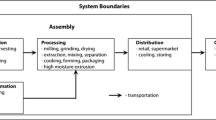Abstract
This paper has been presented at a meeting of the National Research Council in February 1995, in Perugia, Italy. This is a preview of that which is to be the final product of the study: a manual for evaluating the environmental impact of pig-breeding farms. The most important issues in the environment-hog production relationship are discussed. After that, some elements for a sustainable swine production are focused. To solve the pig-breeding/environment conflict is not an easy task. The challenge is to find the right compromises, adopting all possible technologies for minimizing the impact on the environment. Since the first problem is the risk of water pollution due to manure, it is important to study the best solutions from the viewpoint of the watershed, taking into account the interactions and synergies occurring in the drainage system, and especially for the communities at the lower part of the basin. Therefore it becomes more and more of an absolute necessity to plan and manage resources using the watershed as a reference.
Similar content being viewed by others
References
Abbozzo, P., Mennella, V.: 1993, L'impatto delle agrotecnologie nel Bacino del Tevere. Criteri per la valutazione di impatto ambientale, Franco Angeli, Milano.
Cantrell, J.: 1985, A low investment swine system: a demonstration project, Kerr Fundation, Oklahoma.
Carnell, P.: 1983, Alternatives to factory farming. Earth Research LTD, London.
Curtis S.E.: 1983, Environmental management in animal agriculture, Iowa State University Press.
Edelman M.A.: 1994, Hog confinement policy issues and options, Dept. of Economics, Iowa State University, Staff paper 252.
Halverson M.K.: 1991, Using nature as both mentor and model: animal welfare research and development in sustainable swine production, Dept. of Agricultural Economics, University of Minnesota, Staff paper P91-26.
Honeyman M.S.: 1990, Sustainable swine production, Minnesota Extension Service.
Kass et al.: 1980, Utilization of dietary fiber from alfalfa by growing swine, J. Anim. Sci., 50.
Killingsworth M.L., Kliebenstein J.B.: 1984, Estimation of production cost relationships for swine producers using different levels of confinement, J. of Amer. Soc. of Farm Managers and Rural Appraisers 48.
Minnesota Extension Service: 1991, Minnesota Swine Conference for Producers, University of Minnesota.
National Pork Producers Council: 1993, Guide to Environmental Quality in Pork Production, Iowa.
Piva G., Morlacchini, M.: 1990, Riduzione dell'azione inquinante delle deiezioni suine: importanza dell'alimentazione, Riv. di Suinicoltura n.6.
Sorlini C., Magoni M.: 1991, Valutazione di impatto ambientale: impianti di allevamento di suini e bovini, Provincia Autonoma di Trento.
Taylor, A.G.: 1991, Illinois Livestock Waste Regulations, IEPA, Illinois.
Working Group on Watershed Management and Development: 1988, The role of watershed management in sustainable development, FFSD, WP3, Minnesota.
Author information
Authors and Affiliations
Additional information
Prof. Paolo Abbozzo is the Scientific Head of the CNR-RAISA Monodisciplinary Group of the Institute of Estimo Rurale e Contabilità at the University of Perugia; Dr. Antonio Boggia is a teaching/research assistant and Dr. Mauro Brunetti is CNR scholarship holder at the same Institute.
Rights and permissions
About this article
Cite this article
Abbozzo, P., Boggia, A. & Brunetti, M. Environmental quality and hog production. Environ Monit Assess 41, 171–182 (1996). https://doi.org/10.1007/BF00394342
Issue Date:
DOI: https://doi.org/10.1007/BF00394342




